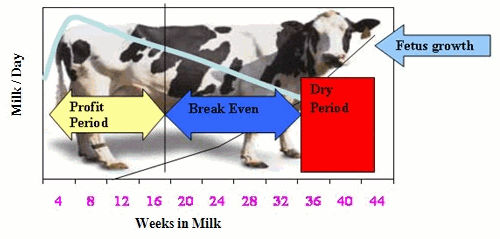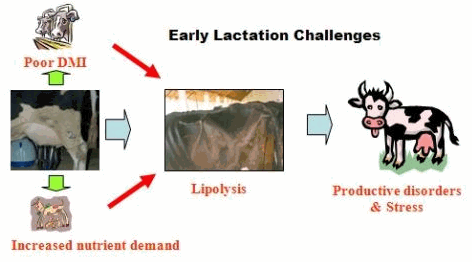



Partitioning Of Nutrients During Lactation In Dairy Animals
There are two main objectives of dairy farming. The first is to get optimum milk production and second is to achieve maximum reproductive potential (i.e. a calf a year) from dairy animals, according to Deepak Kumar Dubey, Kemin Industries, Inc.Understanding the partitioning of nutrients in dairy animals during different phases of lactation cycle, and thereby the need of nutrients according to stage of lactation is important to achieve maximum genetic potential for milk production and reproduction in dairy animals.
This paper focuses on the physiological changes during lactation associated with nutrients partitioning in dairy animals.
Challenges with Present Dairy Breed
Genetic potential of dairy cows has improved significantly during last two decades (Figure 1). Today's dairy animal is called as biological machine, which consume feed and convert it in to milk. During early part of lactation, dry matter intake remains suboptimum thus dairy cow is unable to meet out production requirements though intake. Therefore, cow has to compromise from her body for the nutrients to achieve peak milk yield during early lactation. Due to depleting body stores during early lactation, dairy cows and buffaloes are found more susceptible for metabolic disorders/diseases, reproductive failure, poor immune status, poor body condition etc.

Understanding the lactation cycle commercially and feeding dairy animals accordingly is very much important for a dairy farmer to run a successful dairy farm. As dairy farmer gets more profit through milk during early lactation period, so it may be called as profit period as return on investment is higher (Figure 2) than rest of the lactation period. The following text mentions some important points on how the physiology works during early lactation days and in rest of the lactation period to synthesise milk and maintain body condition.

Partitioning of Nutrients
Partitioning of the absorbed nutrients depends primarily upon the physiological status of the animals, rather than physiological needs of the various tissues and to a lesser extent upon the composition and physical form of the diet ingested by the dairy animals. Endocrine system is very active in nutrients partitioning through its influence on the anabolic and catabolic processes at the tissue level.
In dairy animals, improved milk yield during early lactation is associated with the proportionately greater partitioning of nutrients towards milk synthesis at the expense of body reserve, in order to satisfy the considerable demands of the mammary gland. The partitioning of nutrients to various body tissues involves two types of regulation, "Homeostasis" and "Homeorhesis". Homeostatic control involves maintenance of physiological equilibrium or constant conditions in the internal environment. Homeorhesis is the second type of control in partitioning nutrients. It is defined as orchestrated or coordinated changes in metabolism of body tissues necessary to support a physiological state.
Lactogenesis signals the shift from 'uterine nutrient transfer to foetus' to 'neonatal nourishment' at the mammary gland. Thus, at partitioning, the mammary gland achieves metabolic priority over other tissues to perform the synthesis and secretion of milk. The nutrients deficient in feed are met by partitioning nutrients from body reserves towards mammary gland.
Metabolic Adaptation during Milk Secretion from Mammary Gland
Liver and Kidney
Liver is the major site of glucose production in dairy animals. Meeting the increased demand for glucose to synthesise lactose in mammary gland requires a two- to threefold increase in hepatic glucose production. Liver contains some reserves of glucose as glycogen but these are trivial compared with the need for glucose, hence the requirement is met by increased gluconeogenesis. This is achieved through three mechanisms:
- An increase in liver size although this appears to lag behind the increase in milk yield
- An increase in activity/unit weight of tissues arising from increased activity of gluconeogenic enzymes i.e. Glucose-6-phosphatase, Fructose-1, 6 di phosphatase, PEP Carboxykinase and Pyruvate carboxylase
- The latter arises from an increase in blood flow through the liver
Besides, an increase in propionate and amino acid absorption from gut and increased release of lactate by muscle and adipose tissues, glycerol release from adipose tissues and amino acid release from muscle can also be used for glucose synthesis. Estimates indicate propionate supplies 32 to 73 per cent of the total glucose demand. To serve this purpose, a propionate based gluconeogenic precursor has been formulated by Kemin Industries Inc., named NutroCALTM, which when supplemented to dairy animals has proven to be very much effective in synthesising glucose and optimising milk yield, for various dairy markets globally.
The kidneys also make minor contribution to glucose production through gluconeogenesis. However, neither the size of the organ nor the activities of its key gluconeogenic enzymes alter with lactation. The liver is also major site of lipid metabolism. During early lactation, supply of fatty acid to the liver is increased as a result of a rise in the unesterified fatty acid concentration in the blood (due to increased lipolysis) and the increase in blood flow to the liver.
Adipose Tissue
The physiological changes in dairy animals before parturition prepare the adipose tissues for the massive release of fatty acids, and accordingly, the mammary gland is prepared for receiving the increased supply of nutrients. At parturition there is massive mobilisation of fatty acids from adipose tissues and consequently a dramatic rise in plasma free fatty acids. Simultaneously, there is a considerable increase in the activity of the enzyme lipoprotein lipase in the mammary gland, as a preparatory step for the cleaving long chain fatty acids from the circulating triglycerides.
During the early part of lactation, adipose tissues witness a high rate of lipolysis (Figure 3) and a very low rate of lipogenesis and the dairy animal is in negative energy balance. A cow in early lactation can even lose 20 to 50 kg of fat in 6 weeks.

Optimal nutrition is important to exploit dairy animals genetically for production and reproduction. Losing more fat from body reserve indicates suboptimum nutrition and thus an animal may not be able to show its full potential for milk production. In this way, a dairy farmer faces hidden losses in milk production. Also a healthy body condition is required for proper functioning of reproductive organs. To address this issue, rumen protected fat products such as EnerFATTM have been developed for use in various dairy markets globally. Rumen bypass fat prevents inhibition of rumen microbial activity and fibre digestion which is caused by extra supplementation of rumen active fat. Rumen protected fatty acids escapes from rumen hydrolysis and hydrogenation and provides more energy to high producing dairy animals to produce more milk and fat.
Supplementation of bypass fat is safe and has high caloric value compare to starch and thus, is a good source for increasing energy density of the diet to improve production and reproductive performance.
Skeletal Muscle
A loss of skeletal muscle protein during lactation has been reported. The limited data available suggest that this is primarily due to an increase in protein degradation with little or no fall in protein synthesis. Amino acids released from muscle are probably used either for protein synthesis in the mammary gland or gluconeogenesis in the liver. It is perhaps surprising that there is no fall in protein synthesis in muscle during lactation for this would be a means of conserving energy.
Changes in Hormonal Concentration
Prolactin
Lactation results in an increase in serum prolactin, the primary lactogenic hormone. Prolactin is involved in the development and differentiation of mammary gland. Blocking the prepartum release of prolactin in dairy cows with the specific drug results in a 40 to 50 per cent reduction in subsequent milk production and this effect is overcome by simultaneous administration of exogenous prolactin. Several investigators have proposed that prolactin coordinates lipid metabolism in adipose and liver tissue in a manner to partition nutrients to the mammary gland. Blocking the release of prolactin during lactogenesis or in early lactation produces not only the negative effects on mammary synthesis of milk but also results in an increase in adipose and liver pathways of lipid synthesis as well as reduction in the rates of lipid mobilisation from adipose tissues.
Insulin
During early lactation serum insulin concentration falls in cows, and later recovers as lactation progress and milk yield fall. Insulin is the major anabolic hormone of the body promoting lipid synthesis and inhibiting lipolysis in adipose tissues, promoting protein synthesis and inhibiting proteolysis in muscle, stimulating glucose uptake by muscles, inhibiting gluconeogenesis in liver. Although mammary cells from cow posses insulin receptors, insulin does not appear to have direct effect on mammary cells during lactation in cows, hence a fall in serum insulin should not have any deleterious effects on the mammary gland itself. Insulin appears to be required for the induction of lactogenesis in mammary tissues from cows and water buffalo.
Glucagon
Glucagon antagonises some actions of insulin and the serum insulin: glucagon ratio is thought to be important in the control of liver metabolism. Glucagon stimulates gluconeogenesis and glycogenolysis whereas insulin inhibits these fluxes.
Growth Hormone
During early lactation the concentration rises and then falls during later stages when milk yield falls. Growth hormone promotes the production of insulin-like growth factors (somatomedins) by the liver and these may have effects on the mammary gland.
The action of growth hormone with respect to protein metabolism is anabolic i.e. preserving the protein reserves particularly during energy deficiency by inhibiting proteolysis and stimulating the incorporation of amino acids in to the tissues. As far as lipid metabolism is concerned, growth hormone stimulates lipolysis, and inhibits lipogenesis in the adipose tissues and subsequently stimulate the nutrient mobilisation, by diverting glucose and fatty acids away from tissue deposition towards mammary gland, during lactation.
It has been reported that changes in growth hormone levels in blood are positively correlated with changes in milk yield.
Glucocorticoids
During early lactation the concentration of glucocorticoids rises and then falls during later stages when milk yield falls. They enhance the action of insulin on lipogenesis and antagonise the action of insulin on glucose utilisation. They also help in gluconeogenesis.
Catecholamin
Stimulation of sympathetic nervous system leads to the release of noradrenalin in adipose tissues which increases lipolysis and inhibits lipogenesis. Noradrenalin interacts with beta-receptors on the surface of the adipocyte resulting in a series of reaction which culminate in the activation of hormone-sensitive lipase and hence increased lipolysis.
Role of Nutrition in Lactation
With keeping view of dry matter intake in mind during different phase of lactation, an ideal diet may be prepared for dairy animals to meet out production as well as reproduction requirement. Some of the nutritional points are highlighted below, which may be considered during formulation of diet:
- Different roughage and concentrate rations to fulfill dry matter and nutrients requirement
- Nutrients dense feed may be fed during early lactation
- Different nutritional technologies like bypass fat, bypass protein, chelated minerals etc. may be applied at the time of formulating diet
- Secretion rates and the plasma concentration of insulin and growth hormone could be altered by altering the feeding patterns like dietary roughage concentrate ratio, frequency of feeding, proportion of undegradable dietary protein and physical form of the diet.
Conclusion
A better understanding of physiology during different stages of lactation is very important to decide on the nutritional strategies. Dietary manipulation depending on the specific nutritional needs would be the best tool to economise milk production from dairy animals, along with maintaining proper health and reproductive potential.
January 2010

